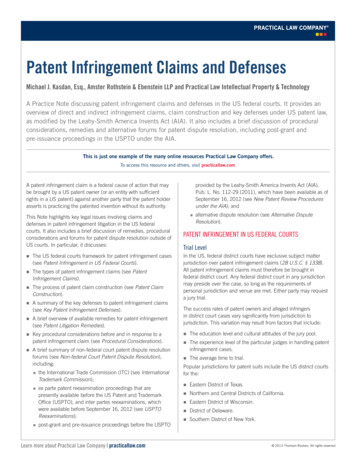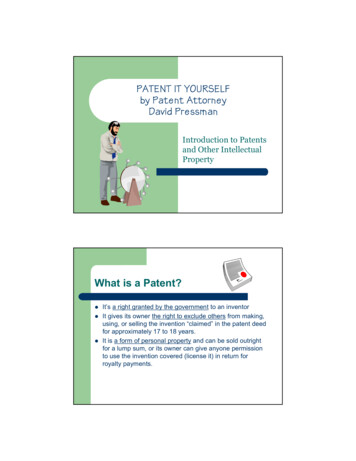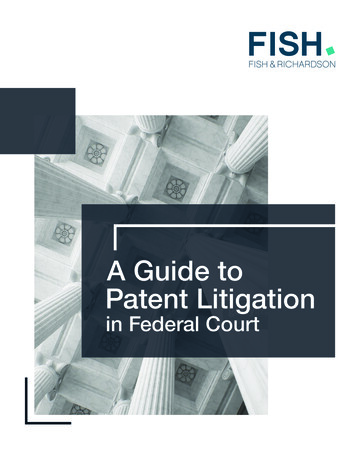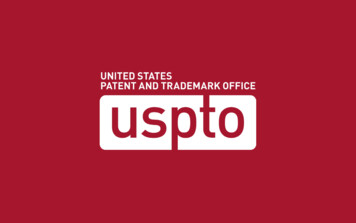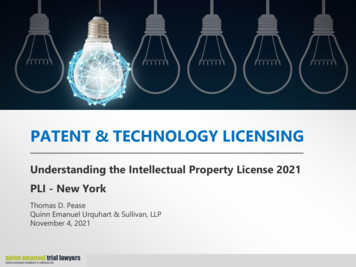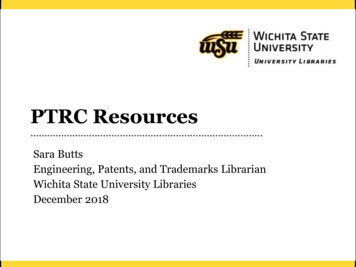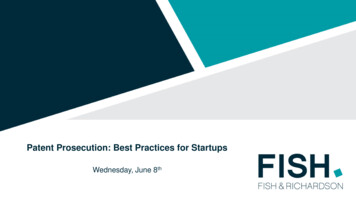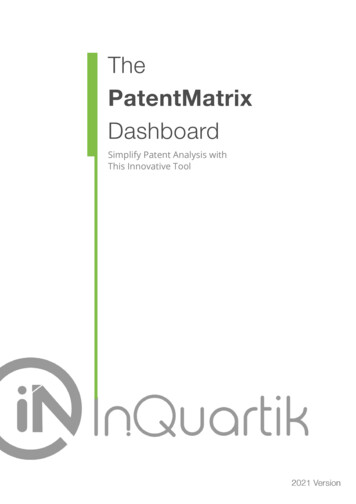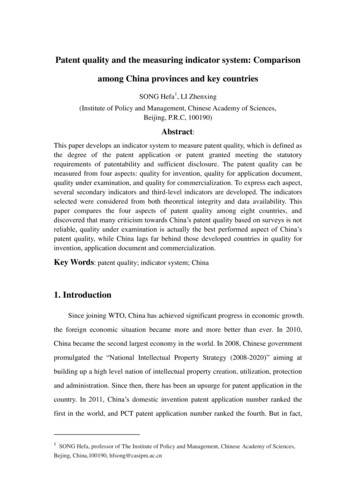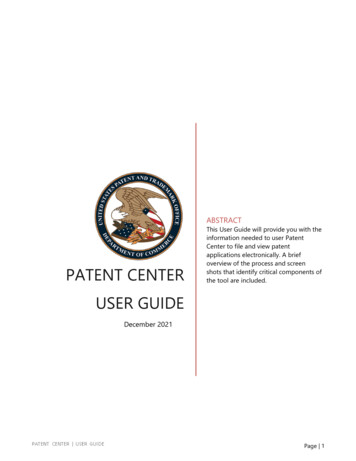
Transcription
Case 1:22-cv-00252-UNA Document 1 Filed 02/28/22 Page 1 of 51 PageID #: 1IN THE UNITED STATES DISTRICT COURTFOR THE DISTRICT OF DELAWAREARBUTUS BIOPHARMA CORPORATION )and GENEVANT SCIENCES GmbH,))Plaintiffs,))v.))MODERNA, INC. and MODERNATX, INC., )))Defendants.)C.A. No.JURY TRIAL DEMANDEDCOMPLAINT FOR PATENT INFRINGEMENTPlaintiffs Arbutus Biopharma Corporation (“Arbutus”) and Genevant Sciences GmbH(“Genevant”) file this Complaint seeking patent infringement damages against DefendantsModerna, Inc. and ModernaTX, Inc. (collectively, “Moderna”) and allege the following:INTRODUCTION1.The impact of the COVID-19 pandemic, one of the greatest public healthchallenges in modern history, would be immeasurably worse but for the rapid, widespreadavailability of cutting-edge mRNA-based vaccines like Moderna’s. Moderna brought its vaccinefrom lab bench to arms in record speed. That unprecedented accomplishment was made possibleby Moderna’s use of breakthrough technology Arbutus had already created and patented—arevolutionary lipid nanoparticle (“LNP”) delivery platform that took the scientists of Arbutusyears of painstaking work to develop and refine. Moderna was well aware of Arbutus’s LNPpatents and licensed them for other product programs, but it chose not to do so for its COVID-19vaccine. Instead, it attempted to invalidate several of the patents before the United States Patent
Case 1:22-cv-00252-UNA Document 1 Filed 02/28/22 Page 2 of 51 PageID #: 2and Trademark Office, and when those efforts largely failed, Moderna simply used the patentedtechnology without paying for it or even asking for a license. Plaintiffs do not seek an injunctionor any relief in this case that would impede the sale or manufacture of Moderna’s life-savingvaccine. They seek only fair compensation for the use of patented technology they developedwith great effort and at great expense, without which Moderna’s COVID-19 vaccine would nothave been successful.2.Medicines using messenger ribonucleic acid (or “mRNA”) technology, likeModerna’s COVID-19 vaccine, rely on synthetic mRNA that enters the body’s cells and instructsthem to make proteins they would not necessarily make on their own. Moderna’s COVID-19vaccine, in particular, uses mRNA to cause cells to make a small piece of the virus that causesCOVID-19 called the “spike protein.” That small piece, which is harmless in isolation, promptsthe body’s immune system to produce antibodies that will recognize the spike protein if it isencountered in the future and destroy it. In this way, the vaccine equips a person’s body aheadof time with antibodies to fight the COVID-19 virus if that person experiences a subsequentexposure.3.Ever since the vast potential for mRNA-based vaccines and other mRNA-basedmedicines began to catch the attention of scientists more than two decades ago, the biggesttechnological hurdle to developing and deploying them has been devising a safe and effectiveway to deliver the mRNA to the cell. Without adequate protection, mRNA quickly degrades inthe body. For mRNA vaccines like Moderna’s to work, they must incorporate a mechanism forprotecting the fragile mRNA, delivering it through cell membranes, and then releasing it inside2
Case 1:22-cv-00252-UNA Document 1 Filed 02/28/22 Page 3 of 51 PageID #: 3the cell. In the words of one Nobel Prize winning scientist, the secret for making RNA-basedproducts work has always been “delivery, delivery, delivery.” 14.Having vexed experts in the field for years, that problem eventually found asolution in the innovative research of Arbutus scientists. Their solution was ingenious:microscopic particles built from four carefully selected types of fat-like molecules, so small thatthey are measured in nanometers but still stable enough to shelter and protect an RNA moleculeon a voyage through the human body to a target cell, and then through the target cell’smembrane, before finally releasing the RNA. These tiny fat-like particles are called “lipidnanoparticles,” or “LNPs.” The United States Patent and Trademark Office has granted Arbutusseveral patents for its groundbreaking LNP technologies.5.LNPs identified through Arbutus’s pioneering work have been described as“crucial” to Moderna’s COVID-19 vaccine, the first mRNA product the company was able tocommercialize and the keystone of its financial success. 2 Without the LNPs Arbutus invented tosafeguard the mRNA and deliver it into cells, the mRNA in Moderna’s vaccine would degradebefore ever reaching the cells it needs to enter and the vaccine would not work.6.Moderna has long been aware of Arbutus’s LNP intellectual property and itsimportance as a component of mRNA-based vaccines and other mRNA-based medicines.Several years before the pandemic, Moderna obtained licenses to use Arbutus’s LNP patents forcertain mRNA products directed to specific viral targets. But those licenses did not grantModerna rights to use the technology for products targeting SARS-CoV-2, the virus that causes1Erika Check, “RNA to the Rescue,” Nature 425:10-12 (2003), available athttps://www.nature.com/articles/425010a.2Nathan Vardi, “Moderna’s Mysterious Coronavirus Vaccine Delivery System,” Forbes.com,July 29, 2020, available at system/.3
Case 1:22-cv-00252-UNA Document 1 Filed 02/28/22 Page 4 of 51 PageID #: 4COVID-19 and that the vaccines at issue here target. Before it decided to use Arbutus’s provenand patented technology as a crucial part of its COVID-19 vaccine, Moderna did not ask for alicense to do so. Instead, it tried to convince the United States Patent and Trademark Office and,later, the United States Court of Appeals for the Federal Circuit to cancel several of Arbutus’sLNP-related patents. But despite the failure of Moderna’s attempts to eliminate Arbutus’spatents, and despite Plaintiffs’ efforts to resolve this dispute without litigation, Moderna hasremained unwilling to pay for its use of Arbutus’s technology in a vaccine that has earnedModerna billions of dollars in profits.7.Moderna’s intransigence has forced Arbutus and Genevant, a companyspearheaded by former Arbutus scientists, to bring this infringement action. Plaintiffs are proudthat their LNP technology has had such a profound impact on the heroic fight against theCOVID-19 pandemic, and they do not seek to impede by an injunction or otherwise theproduction or distribution of Moderna’s COVID-19 vaccine, including boosters. All Plaintiffsseek is the compensation due to them under the patent laws of the United States and as a matterof simple fairness.NATURE OF THE ACTION8.This is a civil action under the patent laws of the United States, 35 U.S.C. § 101 etseq., seeking damages for Moderna’s infringing manufacture, use, sale, offer for sale, and/orimportation of its mRNA-1273 COVID-19 mRNA LNP vaccine product (“Moderna’s COVID19 vaccine”) or any supplemental or booster COVID-19 mRNA LNP vaccine product(collectively, the “Accused Product”).9.As alleged herein, the manufacture, use, sale, offer to sell, and/or importation ofthe Accused Product infringes or will infringe, actively induces or will actively induce4
Case 1:22-cv-00252-UNA Document 1 Filed 02/28/22 Page 5 of 51 PageID #: 5infringement of, or contributes or will contribute to the infringement of, one or more claims ofthe following patents relating to nucleic acid-lipid particles, compositions thereof, and their useto deliver nucleic acid-based medicines: U.S. Patent Nos. 8,058,069 (Exhibit A), 8,492,359(Exhibit B), 8,822,668 (Exhibit C), 9,364,435 (Exhibit D), 9,504,651 (Exhibit E), and11,141,378 (Exhibit F) (collectively, the “Asserted Patents”). At all relevant times, Arbutusowned the Asserted Patents and licensed exclusive rights to sublicense, practice, and sue forinfringement of them to Genevant in certain fields of use that include the vaccine application atissue in this Complaint, with certain exceptions not relevant here (hereinafter, Genevant’s“Exclusive Rights”).THE PARTIES10.Plaintiff Arbutus Biopharma Corporation is a corporation organized and existingunder the laws of Canada, with its principal place of business at 701 Veterans Circle,Warminster, Pennsylvania, 18974. The company’s research and development efforts includediscovering, developing, and commercializing a cure for chronic hepatitis B virus, as well asdrug discovery and development efforts for treating coronaviruses, including SARS-CoV-2,which causes COVID-19.11.Plaintiff Genevant Sciences GmbH is a company organized and existing under thelaws of Switzerland, with its principal place of business at Viaduktstrasse 8, 4051 Basel,Switzerland. Genevant is a technology-focused nucleic acid delivery solutions company withcutting-edge LNP platforms. Genevant owns or licenses the industry’s most important LNPintellectual property—that of Arbutus—and has decades of experience and expertise in nucleicacid drug delivery and development. Genevant, together with its affiliated companies, maintainsoffices in Cambridge, Massachusetts and Vancouver, British Columbia, Canada. Genevant’s5
Case 1:22-cv-00252-UNA Document 1 Filed 02/28/22 Page 6 of 51 PageID #: 6mission is to utilize its LNP and other technologies to deliver innovative new medicines that usemRNA or other nucleic acids.12.Defendant Moderna, Inc. is a corporation organized and existing under the laws ofthe State of Delaware, with its principal place of business at 200 Technology Square, Cambridge,Massachusetts, 02139. Moderna, Inc., itself and through its subsidiary ModernaTX, Inc.,develops, manufactures, imports, markets, distributes, offers to sell, and/or sells vaccines andother medicines in the State of Delaware and throughout the United States, for use in the State ofDelaware and throughout the United States.13.Defendant ModernaTX, Inc. is a wholly owned subsidiary of Moderna, Inc.(collectively, “Moderna”). ModernaTX, Inc. is also a corporation organized and existing underthe laws of the State of Delaware, with its principal place of business at 200 Technology Square,Cambridge, Massachusetts, 02139. ModernaTX, Inc. develops, manufactures, imports, markets,distributes, offers to sell, and/or sells vaccines and other medicines in the State of Delaware andthroughout the United States, for use in the State of Delaware and throughout the United States.JURISDICTION AND VENUEA.Subject-Matter Jurisdiction14.Because this is an action for infringement under the patent laws of the UnitedStates, Title 35 of the United States Code, the Court has subject matter jurisdiction pursuant to28 U.S.C. §§ 1331 and 1338(a).B.Personal Jurisdiction15.This Court has personal jurisdiction over Moderna because, among other things,Moderna, Inc. and ModernaTX, Inc. have purposefully availed themselves of the benefits andprotections of Delaware’s laws such that they should reasonably anticipate being haled into court6
Case 1:22-cv-00252-UNA Document 1 Filed 02/28/22 Page 7 of 51 PageID #: 7here. Because Defendants are organized and exist under the laws of Delaware, are qualified todo business in Delaware, and have appointed registered agents for service of process inDelaware, Moderna, Inc. and ModernaTX, Inc. have consented to general jurisdiction inDelaware.16.Additionally, Moderna, Inc. and ModernaTX, Inc., directly or through others,make, use, induce others to use, offer for sale, and/or sell the Accused Product, and/or acomponent, combination, or composition constituting a material part of the Accused Product,within the United States, and/or import the same into the United States, including into theDistrict of Delaware. For example, on December 18, 2020, Moderna received Emergency UseAuthorization (“EUA”) from the United States Food and Drug Administration (“FDA”) for itsCOVID-19 vaccine to be distributed and administered to people throughout the United States,including in the District of Delaware and, on January 31, 2022, the FDA approved Moderna’sBiologics License Application (“BLA”) for its COVID-19 vaccine. Upon information andbelief, as of February 24, 2022, over 835,000 doses of Moderna’s COVID-19 vaccine have beendelivered to the State of Delaware. 3 Therefore, Moderna, Inc. and ModernaTX, Inc. transactbusiness within Delaware relating to Plaintiffs’ claims and have engaged in systematic andcontinuous business contacts here.17.For the above reasons, there is nothing unreasonable or fundamentally unfairabout requiring Moderna, Inc. and ModernaTX, Inc. to litigate this action in this District, and theCourt has personal jurisdiction over them here.3Delaware Environmental Public Health Tracking Network, Vaccine ov/locations/state/vaccine-tracker (last visited Feb.25, 2022).7
Case 1:22-cv-00252-UNA Document 1 Filed 02/28/22 Page 8 of 51 PageID #: 8C.Venue18.Venue is proper in this District under 28 U.S.C. §§ 1391(c)(2) and 1400(b)because both Moderna, Inc. and ModernaTX, Inc. are corporations organized and existing underthe laws of the State of Delaware and are therefore subject to suit in this District.BACKGROUNDA.How Vaccines Work19.Viruses are typically small packets of DNA or RNA. If a virus enters a livinghost cell—for example, after being ingested, transmitted through bodily fluids, or inhaledthrough a person’s mouth or nose—the virus’s DNA or RNA hijacks the cell’s machinery andinstructs the cell to make copies of the virus. These copies, often numbering into the millions,leave the infected cell and enter other cells where the process repeats. Infected cells can bedamaged or die while hosting the virus. Left unchecked, the host organism itself can die.20.Although vaccines targeting viruses have different mechanisms of action, theytraditionally work by injecting into the body a weakened or inactive form of the virus that isunable to cause infection, but nonetheless retains features of the infectious virus and can teachthe immune system to recognize and attack the infectious virus if it invades in the future.B.Nucleic Acid Medicines and Delivery Technologies21.Moderna’s COVID-19 vaccine belongs to a new class of medicines that delivernucleic acids into the cells of the body to treat diseases or, in the case of Moderna’s COVID-19vaccine, to trigger an immune response to protect a person from future infection.22.Nucleic acids are molecules that encode the genetic information essential tosustain all forms of life. One type of nucleic acid is deoxyribonucleic acid, or “DNA,” which isfound in our chromosomes. In humans, each person (except identical twins) has a unique set of8
Case 1:22-cv-00252-UNA Document 1 Filed 02/28/22 Page 9 of 51 PageID #: 9genetic information in the “genes” within his or her chromosomes. Among other things, thesegenes spell out the instructions for producing proteins that make our cells and bodies function.23.In order to make the protein encoded by a particular gene, the cell first convertsthe genetic code in the gene’s DNA into another type of nucleic acid known as messengerribonucleic acid, or “mRNA.” mRNA is effectively a copy of the portion of DNA that the cell’sprotein-making machinery uses as a blueprint to assemble the protein encoded by the gene.24.Vaccines and other medicines using ribonucleic acid, or “RNA,” technologies arean emerging frontier with the potential to revolutionize medicine. RNA-based medicines canemploy a type of RNA called small interfering RNA (“siRNA”) to treat certain diseases byinterfering with the expression of unwanted proteins to reduce the amounts produced—a processcalled RNA interference (“RNAi”). RNA-based medicines also can employ mRNA to cause orincrease the production of certain proteins. mRNA vaccines, for example, cause cells to expressa protein (or a piece of a protein) that is normally found on a particular tumor or that is part of aparticular virus. The presence of that protein (or piece of a protein) teaches the body’s immunesystem to recognize it if it is encountered in the future and destroy it. These and other RNAbased medicines hold great promise for addressing many previously intractable diseases and, asin the present circumstances, new viruses that cause or threaten worldwide pandemics.25.Despite their promise, however, RNA-based medicines have been difficult todevelop. By their nature, RNA molecules are fragile. Without adequate protection, RNAmolecules are susceptible to degradation in the body, and, if and when they get to a cell, cannotcross the cell membrane to enter the cell. For decades, the need for an effective deliverytechnology had been the most significant challenge in the development of RNA-based products.9
Case 1:22-cv-00252-UNA Document 1 Filed 02/28/22 Page 10 of 51 PageID #: 10In particular, without the means to protect mRNA and facilitate its entry into target cells,mRNA-based vaccines and other medicines have been ineffective.26.Indeed, functional RNA-based medicines eluded researchers until the pioneeringwork by Arbutus scientists, many now at Genevant companies, resulting in the discovery anddevelopment of the leading nucleic acid delivery technology in use today. Decades ago, a groupof ambitious research scientists working at a predecessor company to Arbutus began to tackle thenucleic acid delivery problem that had long stymied the field. Years of tireless effort by thesescientists resulted in a solution to the problem. The solution was LNP technology that relieson fat-like molecules called lipids that encapsulate and protect nucleic acids like mRNA fromdegradation in the body and enable them to cross cell membranes. Once inside a cell, the LNPreleases the nucleic acid it encapsulates so that, in the case of an mRNA vaccine for example, thenucleic acid can express the protein it encodes.27.The lipid components of the Arbutus technology include: structural lipids, such asphospholipids and cholesterol; “cationic” (positive charge-bearing) lipids, including “ionizable”lipids that are positive charge-bearing at certain pH levels; and conjugated lipids, which arelipids attached to a polymer such as polyethyleneglycol (“PEG”). Arbutus scientists discoveredthat nucleic acid-lipid particles combining particular lipid components in particular ratios couldachieve much more effective delivery of nucleic acids through cell membranes and into cells.28.These Arbutus scientists spent more than a decade researching and developingthis nucleic acid-lipid delivery technology. Their efforts led to the first FDA-approved RNAbased therapeutic in the form of a drug called Onpattro , an RNAi treatment for a form ofamyloidosis, a rare disease that causes certain proteins to accumulate in organs. The companythat developed Onpattro , Alnylam Pharmaceuticals, did so under an LNP license from Arbutus10
Case 1:22-cv-00252-UNA Document 1 Filed 02/28/22 Page 11 of 51 PageID #: 11and received FDA approval in August 2018. Building on this initial success, Arbutus hasgranted licenses to its LNP technology to other companies, and Genevant now has severalongoing LNP product development collaborations, some directed to COVID-19 and somedirected to other diseases and disorders. Several entities developing mRNA-LNP vaccinesagainst COVID-19 have come to Genevant for a license to Arbutus’s technology, includingcompanies that have produced promising candidates in clinical trials. And Genevant’s COVID19 development collaborations include efforts to provide a vaccine to parts of the developingworld.C.The United States Awards Patents Recognizing Arbutus’s Innovations29.In recognition of Arbutus’s extensive and groundbreaking research anddevelopment efforts, the United States Patent and Trademark Office has granted several familiesof patents claiming nucleic acid-lipid particles and lipid vesicles, as well as compositions andmethods of using them. The Asserted Patents are among them:a. U.S. Patent No. 8,058,069, “Lipid Formulations for Nucleic Acid Delivery,”issued on November 15, 2011 (the “’069 Patent”).b. U.S. Patent No. 8,492,359, “Lipid Formulations for Nucleic Acid Delivery,”issued on July 23, 2013 (the “’359 Patent”).c. U.S. Patent No. 8,822,668, “Lipid Formulations for Nucleic Acid Delivery,”issued on September 2, 2014 (the “’668 Patent”).d. U.S. Patent No. 9,364,435, “Lipid Formulations for Nucleic Acid Delivery,”issued on June 14, 2016 (the “’435 Patent”).e. U.S. Patent No. 9,504,651, “Lipid Compositions for Nucleic Acid Delivery,”issued on November 29, 2016 (the “’651 Patent”).11
Case 1:22-cv-00252-UNA Document 1 Filed 02/28/22 Page 12 of 51 PageID #: 12f. U.S. Patent No. 11,141,378, “Lipid Formulations for Nucleic Acid Delivery,”issued on October 12, 2021 (the “’378 Patent”).30.True and correct copies of the Asserted Patents are attached hereto as Exhibits Athrough F. All are valid and enforceable under United States patent laws. All are assigned toand owned by Arbutus, and, at all times since Arbutus and Genevant entered into a licenseagreement, Genevant has held Exclusive Rights to all of the Asserted Patents in various fields ofuse including the vaccine application at issue here. Under the terms of the license, Genevant’sExclusive Rights include the right to sue for the infringement alleged in this Complaint.D.Moderna’s Knowledge of, and Background with, the Asserted Patents31.Moderna has been on actual notice of Arbutus’s patents since before itsdevelopment of the Accused Product and has knowingly used Arbutus’s technology as anessential component of its nucleic acid products and product candidates, including its COVID-19vaccine.32.Years before the COVID-19 pandemic, Moderna recognized that Arbutus’s LNPtechnology could fuel its own work in RNA-based vaccines and other medicines. Accordingly,in or about May 2015, Moderna attempted to acquire rights to Arbutus’s LNP deliverytechnology for four specific viral targets (none of which is COVID-19) through sublicense froma Canadian company called Acuitas Therapeutics. Although Acuitas had licensed Arbutus’sLNP technology in 2012, its license agreement expressly limited Acuitas’s ability to grantsublicenses. That limitation prohibited Acuitas from granting the sublicense that it granted toModerna.33.In August 2016, after learning of the Moderna-Acuitas sublicense agreements,Arbutus notified Acuitas of material breach. In October 2016, Acuitas filed suit in the Supreme12
Case 1:22-cv-00252-UNA Document 1 Filed 02/28/22 Page 13 of 51 PageID #: 13Court of British Columbia seeking to prevent Arbutus from terminating the Arbutus-Acuitasagreement. Arbutus counterclaimed for a declaration that the license had been terminated andsought an injunction barring Acuitas from further sublicensing Arbutus’s LNP technology.34.In February 2018, Arbutus and Acuitas settled their dispute. The settlementagreement provided that Acuitas no longer could use Arbutus’s LNP technology, with the fourspecific sublicenses to Moderna for vaccines targeting specific viruses remaining in effect.SARS-CoV-2, the virus that causes COVID-19 and the target of the vaccine accused ofinfringement in this Complaint, is not among the surviving sublicenses.35.Deprived of a broad license to Arbutus’s valuable LNP technology and hoping tomake unrestricted use of that technology without having to pay royalties, Moderna began filinginter partes review (“IPR”) petitions requesting that the Patent and Trademark Office cancelcertain of Arbutus’s patents, including some asserted here.36.Moderna’s first IPR petition, filed in February 2018, challenged Arbutus’s U.S.Patent No. 9,404,127 (“the ’127 Patent”), which, like the Asserted Patents, is directed toArbutus’s LNP technology. The Patent Trial and Appeal Board (“PTAB”) ruled that all claimsof the ’127 Patent should be cancelled. An appeal of that decision remains pending before theUnited States Court of Appeals for the Federal Circuit.37.Moderna’s IPRs against the Asserted Patents were less successful. Its second IPRpetition, filed in March 2018, ended with the PTAB rejecting Moderna’s arguments challengingthe validity of ten of the ’435 Patent’s twenty claims. Moderna challenged that ruling on appeal,13
Case 1:22-cv-00252-UNA Document 1 Filed 02/28/22 Page 14 of 51 PageID #: 14but in a December 2021 decision, the United States Court of Appeals for the Federal Circuitdismissed Moderna’s appeal for lack of standing. 438.Moderna’s third IPR petition, filed in January 2019, was even less successful.The PTAB completely rejected Moderna’s challenge to all claims of the ’069 Patent, and theUnited States Court of Appeals for the Federal Circuit affirmed that ruling in December 2021.E.Moderna Designs Its COVID-19 Vaccine Over a Single Weekend Aided by theUnauthorized Use of Arbutus’s LNP Technology39.On January 10, 2020, with the novel SARS-CoV-2 virus quickly spreadingaround the world, scientists identified the virus’s complete genetic sequence and posted it forfree on the internet. This public disclosure revealed the complete RNA sequence that encodesthe virus’s components, including its distinctive “spike protein.” With that information in thepublic domain, researchers around the world were able to begin designing vaccines to target thevirus.40.Moderna was one of many companies that began work on a vaccine in earnestonce the genetic sequence was published.41.Relying on Arbutus’s LNP technology covered by the Asserted Patents, Modernawas able to begin producing its COVID-19 vaccine within just a few days of the SARS-CoV-2genomic sequence entering the public domain. The design component of the effort was evenfaster: According to Moderna President Stephen Hoge, “[w]e did it in an hour, and it workedbrilliantly.” 5 Compared to the timelines of prior vaccine-development efforts, Moderna’saccomplishment was unprecedented. In the words of Moderna’s CEO Stéphane Bancel, “114Arbutus cross-appealed the PTAB’s decision, challenging the invalidation of the ten claims ofthe ’435 Patent that were not upheld. On December 1, 2021, the Federal Circuit affirmed thePTAB’s decision as to those claims.5“Stephen Hoge, MD ’03: Turns out, designing a COVID vaccine was easy,” UCSF Alumni,available at https://alumni.ucsf.edu/stories/stephen-hoge.14
Case 1:22-cv-00252-UNA Document 1 Filed 02/28/22 Page 15 of 51 PageID #: 15months since the DNA sequence of the virus became available, you will have two approvedmRNA vaccines, which has never happened before with any technology. That is amazing.” 642.Moderna’s success was chronicled in an article first published online on June 11,2020, by individuals affiliated with the company and collaborators at the National Institutes ofHealth. According to this article—the “Moderna/NIH preprint”—“the release of SARS-CoV-2sequences triggered immediate rapid manufacturing of an mRNA vaccine” by Moderna. 7Moderna “decide[d] on [the] mRNA-1273 sequence” on January 13, 2020, just three days afterthe publication of the viral sequence, and “initiate[d] cGMP production” the very next day, onJanuary 14, 2020. 8 On February 24, 2020, Moderna shipped clinical drug product, and, less thana month later, Phase I trials began. 943.Moderna’s COVID-19 vaccine could not have been developed, much less on atimeline unprecedented in human history, without Arbutus’s proven and patented LNP deliverytechnology—technology that had transformed vaccine design from a years-long project into onethat could be performed within an hour over a January weekend.44.Moderna’s co-founder Robert Langer has been quoted as saying “I don’t thinkpeople realized just how important the delivery systems are . . . .” 10 LNPs are so crucial to6Antonio Regalado, “‘None of us were ready’ to manufacture genetic vaccines for a billionpeople,” MIT Technology Review (December 17, 2020), available o/.7“SARS-CoV-2 mRNA Vaccine Development Enabled by Prototype Pathogen Preparedness,”bioRvix.org (June 11, 2020) available 11.145920v1.full.8Id.9Id.10Tim Loh, “Lipids Are Delivering the Vaccine Revolution,” Bloomberg (March 6, 2021),available at -06/lipids-are-delivering-thevaccine-revolution.15
Case 1:22-cv-00252-UNA Document 1 Filed 02/28/22 Page 16 of 51 PageID #: 16Moderna’s mRNA vaccines that Giuseppe Ciaramella, head of infectious diseases at Modernafrom 2014 to 2018, called LNPs “the unsung hero of the whole thing,” 11 while Moderna CEOStéphane Bancel stated in December 2020 that “[w]e always said it is . . . about developing theright delivery technology. And this is something that takes years, not two weeks.” 1245.The Moderna/NIH preprint detailed Moderna’s use of Arbutus’s LNP technologyand its infringement of the Asserted Patents. The scientists who worked on the vaccine andcontributed to the article explained that Moderna’s COVID-19 vaccine is composed of mRNAencoding a modified version of the SARS-CoV-2 spike (S) protein that was synthesized,purified, “and encapsulated into lipid nanoparticles (LNP),” with a lipid molar ratio of“50:10:38.5:1.5 (ionizable lipid:DSPC:cholesterol:PEG-lipid).” Specifically, the Moderna/NIHpreprint indicates that the Accused Product includes lipid particles comprising the followinglipids in the following ratio: 50 mol % of an ionizable lipid that is cationic; 10 mol % of aphospholipid (DSPC); 38.5 mol % of cholesterol; and 1.5 mol % of a conjugated lipid thatinhibits aggregation of particles (PEG-lipid).46.These components are within the ranges of, among other claims of the AssertedPatents, Claim 1 of Arbutus’s ’069 Patent, which recites a “nucleic acid-lipid particle comprising(a) a nucleic acid; (b) a cationic lipid comprising from 50 mol % to 65 mol % of the total lipidpresent in the particle: (c) a non-cationic lipid comprising a mixture of a phospholipid andcholesterol or a derivative the
6. Moderna has long been aware of Arbutus's LNP intellectual property and its importance as a component of mRNA-based vaccines and other mRNA-based medicines. Several years before the pandemic, Moderna obtained licenses to use Arbutus's LNP patents for certain mRNA products directed to specific viral targets. But those licenses did not grant
